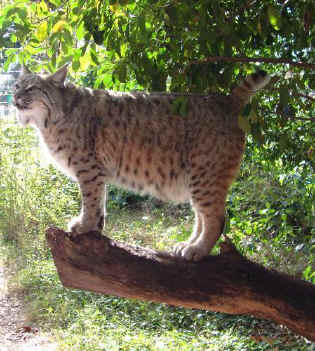This article was written in January 2002
MAKING DREAMS A REALITY
Have you ever dreamed of visiting a place with over 170 exotic cats, from lions to leopard cats, tigers to bobcats, 22 species in all, available for the public to see? Well there is such a place, just ten minutes from Tampa International Airport in Florida. When I found Wildlife on Easy Street on the Internet I could not believe my eyes. Despite the fact that it was three thousand miles away in America, I knew that I just had to visit this place.
I stumbled upon Wildlife on Easy Street (WOES) by chance while searching for information about Sand Cats, a small feline species living in the Sahara and the Middle East, for an essay I was writing for my feline studies diploma. I couldn’t believe my eyes as I read page after page about different rescued wild cats living at the sanctuary. At the time, my husband was trying to find me a very special present for my 40th birthday. Now I really knew what I wanted – a trip to WOES would be a dream come true.

Male Sand Cat at Twycross Zoo, August 2001
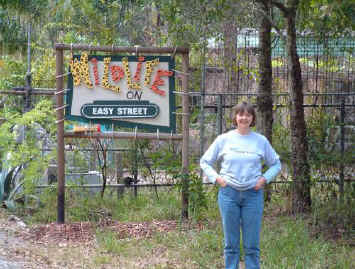
Wildlife
on Easy Street was started in 1993 by Carole Lewis and her husband Don.
Carole’s affinity towards cats (which included breeding Persian Longhairs for
a while) would eventually lead her to having one of the largest exotic cat
rescue sanctuaries in the world. Carole is a Real Estate Agent (similar to an
estate agent in the UK). One day back in the early 1990s she attended an exotic
animal auction and amongst the items for sale was a Bobcat kitten. Thinking that
it would be a great idea to own one of these cats, Carole bid and bought it.
Shortly afterwards, she thought that it would be nice for her Bobcat to have a
few friends, so after much searching, managed to locate a place where Bobcats
were bred. She drove from Florida to Minnesota, and upon arriving at the farm,
was horrified to find that it was actually a fur farm. In her naivety, she
thought that the owners were probably breeding mink, went ahead and chose her
six new Bobcat kittens. After choosing her new babies, she casually asked what
would happen to the other Bobcats if they weren’t sold. She was told that they
would be used in the fur trade. (A point to note is that only the pale tummy fur
is used, the rest of the pelt is discarded and it takes twenty Bobcats to make
one fur coat!) Horrified, she bought all 56 Bobcats and brought them back to
Florida, where she enlisted the help of friends and family to raise them. Being
just a couple of weeks old, they still needed to be bottle-fed and it was a
round the clock job for all concerned. So Wildlife on Easy Street was born.
Being in Real Estate, Carole had her finger on the pulse and eventually managed to locate 40 acres of derelict land, being sold very cheaply because it was a filled-in refuse dump, full of old bicycles, cans and rubbish. Over the years it has been transformed into a leafy refuge for rescued large cats and today you would never guess its original purpose. According to those who work there, an occasional piece of metal can still rise to the surface after very heavy rainfall and the volunteers spend much time checking that the ground is safe to walk on for both man and feline.

Now landscaped, it is difficult to
imagine that this used to be a refuse site
Over the
years many cats have spent time at Wildlife on Easy Street. Unlike in Britain,
where one must hold a special licence to obtain a wild cat, in America it is
very different – if you know where to look, you can buy a tiger cub on a
street corner in Miami or from sites on the internet, and take it home – no
major restrictions or licence required, although some states do require a
permit. Cute as they may seem when they are small kittens or cubs, they soon
grow into large animals, and many become unmanageable in a home environment. The
lucky few end up here, but many more are destroyed or sold to game farms in the
USA where people will pay to hunt and kill them. Hearing this really made me
feel quite sick and I am very thankful that we have more restrictions in the UK
to prevent similar occurrences.
In all, I made three visits to WOES during my week in Florida. Having arrived at Tampa on Thursday evening, I spent Friday visiting a Maine Coon breeder and then, with two American friends, headed to the sanctuary for a “Wild Eyes At Night” experience. This event takes place on the last Friday of every month, after dark, about 8.00pm in our case. Our guide, Jennifer, took us around the sanctuary in the dark, with just a flashlight. It was a good opportunity to see some of the shyer cats, many of which sleep during the day. It was quite daunting to see the 850 lbs Siberian-Bengal cross Tiger come bounding up to us from the hidden depths of his three acre pad. Known as Shere Khan, his story is all too familiar to those working at WOES. Provisionally sold as a very small cub by a tiger breeder, his new owners refused to pick him up, because he was not white, and the breeder kept him in a pet carrier until he was four months old when Don and Carole discovered him, while flying through Indiana. Consequently he did not receive enough calcium, nutrition and exercise and by the time he arrived at WOES some three months later, his teeth and bones were in a very sorry state. His baby teeth were disgraceful and had rotted through his face, causing the need for surgical drains to be installed. After much supplement and tender loving care he is now the largest cat on the premises although he still doesn’t look “quite perfect”. There are several cats living at Wildlife on Easy Street who have suffered a comparable fate with similar consequences
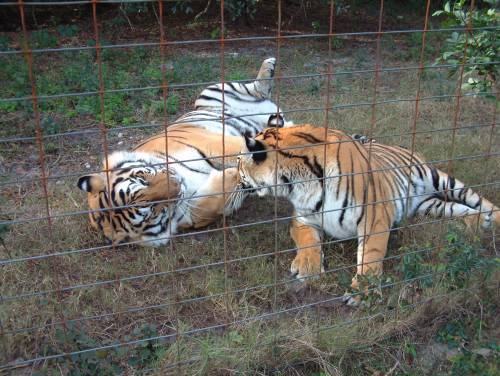
Shere Khan (left) and China Doll (right)
As we wandered round in the darkness we were greeted by various noises as the cats recognised Jennifer, from tigers chuffing to lions roaring. We met Nikita, a lion cub who was WOES’s latest addition, arriving just a couple of weeks before my visit. What a character, chasing her tail, rolling over and doing head stands. She had been confiscated from a drug dealer during a raid and spent a short time at a zoo before arriving. Because she had been de-clawed, she could not remain at the zoo to run with fully-clawed lions and money was raised to bring her here, along with three Bobcats rescued at the same time.

Nikita the lion cub.
We also met Shaquiel, a rather shy Black Leopard who had been badly mistreated by his pervious owner when he wouldn’t perform in a Las Vegas nightclub. As we walked round we saw Fishing Cats, Jungle Cats, Servals, Caracals, Lynx, Bobcats, Ocelots, and lots of Pumas (also known as Mountain Lions or Cougars) as well as the odd domestic cat. This tour lasted almost two hours, and was well worth the $20 we paid.
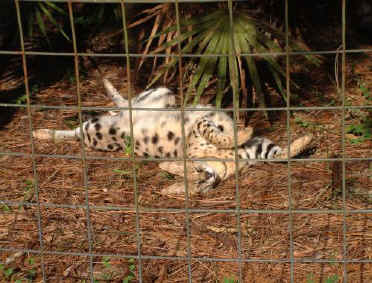
The following day we started our real adventure, known as “Expedition”. Arriving at 9.00am, we were taken through the rules before being given our “Volunteer” t-shirts, which we were told to wear at all times when on site to allow identification. The main rule is “The Three Foot Rule”. Even if there are no barriers between you and the cats’ pen for some reason, and even if it seems the sweetest cat in the world, rubbing its head along the cage wire, don’t ever go closer than three feet. After all we, are dealing with wild cats here, some of which would just love to taste a finger or two. Failure to obey this rule leads to immediate expulsion from the site. Of course, there are occasions when the three-foot rule doesn’t count – but more about that later. After our initial talk, we then headed off into the main sanctuary to meet the cats. For anyone who wishes to see wild cats up close, this place really is a dream come true. We were greeted by Shere Khan – looking even bigger in the light of day, and his companion, China Doll. We watched Pisces the Fishing Cat dive into his pool for food, half a dozen ex-circus tigers all looking for attention, three lions including Nikita, the cub, still doing headstands and chasing her tail, Enya the cougar, who was recovering from liver failure, various groups of Lynx with the biggest ear tips I have ever seen, Bobcats lazing in the grass, Ocelots with amazing coat markings, Amur Leopard Cats, Jungle Cats, Servals being “hissy” (apparently that’s what they are best at), elegant Caracals, huge Leopards both spotted and black and five Sand Cats, the species that had helped me to find WOES in the first place.
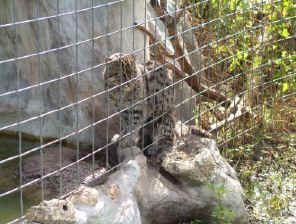
Pisces the Fishing Cat
The list goes on and on. Each cat had its own story, and many did enjoy human attention, coming over to greet out tour guide, Jamie. As well as cats, there was also a group of Binturongs (Bear Cats, not a real cat but a member of the mongoose family) including a big male called Banjo, clumsily climbing a tree. When he gets excited he smells like popcorn cooking! There was a family of lemurs, who arrived after their owners divorced. But the love of my life was Hercules, a male Snow Leopard. He was just wonderful, with a tail so long that it curled round and round over his back, and feet that looked far to big for the body, reminding me of a clown. Hercules was house-reared but now lives in at large purpose-built cat-a-tat (WOES’s name for a cage) with a walk-in freezer cleverly hidden in fake rock, which enables him to keep cool during the hot Florida summers. It was quite a shock to learn that this endangered species can still be purchased as a pet in America. I really loved him and visited him several times during my time at the sanctuary.
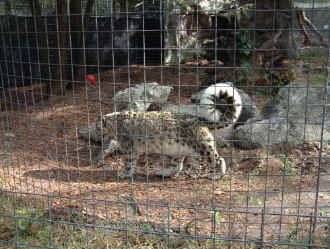
Hercules
We were accompanied on our tour by various domestic cats, which were free to go where they liked. Interestingly, they were all well aware of the three-foot rule too! I guess that they would only make a mistake once, judging by how interested the big cats were in them.
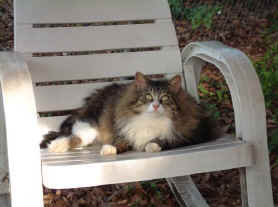
Fancy, one of the domestic cats
The tour
lasted about two hours and then we started our interaction. Some of the cats are
so tame that people are allowed to go into their cat-a-tat with them and this is
when the three-foot rule can be broken. Before entering each cage, we
disinfected our hands, and were reminded that we were now entering their home
and should respect this fact. If they didn’t wish to be petted, then it was
their choice and we mustn’t pursue them. This was my chance to
actually touch Caracals, Lynx, Bobcats and a Serval. Elijah, one of the
Caracals, took an instant liking to me, making a beeline for me on each occasion
– he wanted my camera, he rubbed against my legs and on one occasion tried to
jump up. Sadly this last action meant that we had to leave – the cats are not
allowed to jump up for safety reasons, and this rule is strictly adhered to. The
rising star of the interactive cats was Moses – a Southern Bobcat who had been
left, dumped in a carrier, at the gates of the sanctuary a few months
previously. Still a kitten, he just wanted to play, and when you threw his toys
(yes, cat toys just like we have at home, but bigger) he would bring them back
to you. It is difficult to believe that I played ball with Bobcats, felt the
difference in coat texture between them and the Lynx, and stroked a very
beautiful Serval called Esmerelda. We had three interactive sessions in total,
visiting seven different cat-a-tats and it was a great opportunity to take
photos without the cage wire being in the way.
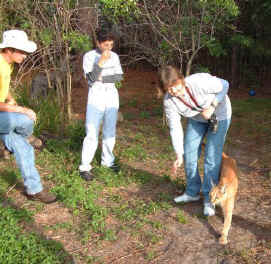
After a short
break for lunch, we were off again. The first afternoon activity was training
– the cats, not us. This is not performance training, but essential training,
getting the cats to stand up on their hind legs against the cage wire so the
paws and underbody can be examined. They also learn to go into their
“lock-out”, a small cage attached to each cat-a-tat. Their water is kept
here, and this is where they are fed so they associate this place with good
things. But there is another important feature of the lock-out. If an animal
needs to be closely examined, given medical treatment or moved (either to visit
the vet, or in extreme weather conditions, such as a hurricane), this is where
they go. The lock-out is detachable, enabling a safely caged animal to be
transported as required. We all got
the chance to try our hand at training, some worked with Conan, a large tiger,
others including myself, worked with Catrina, the cougar, getting her to stand
up, go into “lock-out” and sit down on all fours. We did have a few problems
with my English accent, but got there eventually. Reward was given in the form
of a piece of meat on a long stick and the cats seem to enjoy this interaction.

One of
my friends, David, works with Conan
The next session was enrichment, where we all had to make up special boxes of goodies. We placed meat, fish, or large bones together with fresh herbs in the box before sealing it and rubbing the outside to make it smell attractive to the cat. Our job was to hide the box in the cat’s pen, whilst the cat was safely locked up in its lock-out. Then the cat was released to find its box. I hid my box in Sabre’s pen. Even though this huge black leopard was safely locked up, the adrenaline still pumped around my body as I entered his cat-a-tat. On his release, he sniffed round before jumping up on the mound where the box lay and began to tear it open. It was interesting to note that in the majority of cases, the cats were more interested in ripping up the box to play with, rather than eating its contents, a sign that these cats were very well fed.
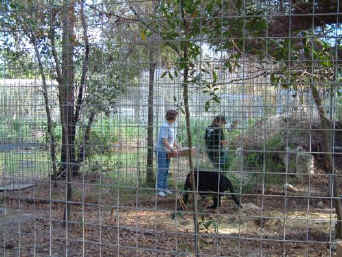
Hiding the box in
Sabre's cat-a-tat
After another interactive session, it was time to give the cats their daily feed. At this point of the day, its all hands on deck with over two hundred animals to feed before darkness falls. The sanctuary has three full time employees and about thirty volunteers who work on a rota to keep things ticking over. Many of the volunteers have a full time job and still manage to spend a further twenty to forty hours a week working at the sanctuary. There are different grades of volunteer, depending on their hours and experience. Some spend their time working in the gift shop, others keep the grounds tidy or cut up food. Gradually, as their experience widens, they will start to help with the various animals, eventually having more responsibility for certain felines. It is plain to see that these people build up excellent bonds with their charges; helping them to overcome any difficulties they had prior to arriving at WOES. We all got the chance to feed Shere Khan - he ate nine chicken legs at one sitting. Other food in the form of red meat chunks and minced meat mixed with vitamin and mineral powder are also given to ensure the cats obtain a healthy balanced diet. Each cat has a set diet, listed on a sheet, and on Sundays the cats are not fed at all, to give their bodies a “rest day”. This is an approved method at zoos and sanctuaries across the world, for keeping the carnivorous cats in the best of health. As we approached each pen, the cats ran into their lock-out, ready for their dinner. I also fed a cougar, although this cat wasn’t quite as polite as the tiger and snatched the large chunk of red meat greedily. During feeding time, I was lucky enough to see Two Toes, the Bobcat that I had adopted back in the summer. She is an ex-fur farm cat and very nervous, only coming out to eat. I had originally chosen to adopt her because of her name, in memory of one of my old cats, also called Two Toes. Because she is so nervous, no one had ever adopted her, probably because they never get to see her. I was fortunate, managing to obtain some video of her eating her food.
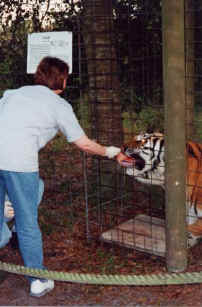
Me feeding Shere Khan
As darkness
fell, we left the main body of the sanctuary to head for our cabin, since we had
made arrangements to spend the night there. Once it becomes dark, you are not
allowed to wander around the site just in case you trip over the barriers and
have an accident. However, you may leave the site but must be back by 10.00 pm.
I had booked the Kenya Cabin, which was part of a converted barn. However, once
inside you would never have guessed it, with all modern conveniences, such as TV
and microwave present. The décor was amazing, photos of African wild cats hung
on every wall, drapes and cushions of lions, and even the shower curtain design
was big cats. The bedspread was of lions and tigers and to top the lot we had
CCTV, which focused on the Sand Cats. What more could we ask for? Right outside
out door was a cat-a-tat where Little Feather, one of the original Bobcats lived
and we spent a considerable amount of time watching her prowl around her pen in
the darkness. We could also hear the lions roaring in the distance.
The following
morning we took a walk around the sanctuary to see the cats again before meeting
with the others for our last interaction of the tour. Once again we played ball
with the bobcats, especially Raindance who was a real favourite, threw toys for
Moses, and Elijah the Caracal took another liking to my jeans. Thankfully no one
sprayed on us during our visit, but it is not unheard of! Before leaving I made
arrangements to adopt Hercules and Canyon the Sand Cat who was responsible for
me find the sanctuary in the first place. As the gate closed behind us and we
drove back up the dirt track to the main road, I knew that my dream had finally
become reality. I had been able to spend time with wild cats.

Moses
the Bobcat enjoys playing with one of the guests
According to
the web site, Wildlife on East Street isn’t too easy to find because they are
not allowed to have a big sign to advertise it. There is just a small discreet
sign on a post with the picture of a running tiger. However, we had no problems
finding the place, and it really is just ten minutes or so from Tampa
International Airport. I left the sanctuary feeling rather bitter-sweet and very
emotional. Whilst it had been wonderful to see so many feline species in one
place, the fact that they were all there because they were rescued or unwanted
was very sad. Some had been abused or severely underfed at their previous home.
However, they are the lucky ones – in 2001, twenty-three new cats arrived, but
fifty-one had to be turned away though lack of space and finances. This place
has no outside financial help, it must be self-supporting and in 2001 it cost
around $375,000 to maintain, $347,000 was raised in donations and the rest came
out of Carole Lewis’ own pocket. One hundred percent of all donations go
towards caring for the animals.
But that
wasn’t the end of my experience. The following Thursday I convinced my friend
Melissa that we needed to go back to take just one more look, so we got up at
6.00 am, drove north for an hour and a half (I was by this time staying with
some friends near Sarasota) and arrived for the standard morning tour, where we
once again visited the various cats and had interactive time with my friend
Elijah. I was fortunate enough to meet the founder, Carole Lewis, with whom I
had been in contact via e-mail over several months. It was great to put a face
to the name. I told her that it’s a pity that WOES is so far away from
Sheffield, since I would have loved to become a real volunteer.
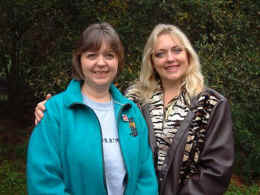
Carole (right) and I meet
Wildlife on
Easy Street has had some famous visitors, including Ian Anderson of the rock
group “Jethro Tull”. Ian is a real cat lover, who actually has a link from
his website to WOES. I managed to contact Ian, telling him of my experiences at
the sanctuary. Ian replied, saying of WOES, “Like all sanctuaries of that
sort, they have the dilemma of showing for the public and housing animals who
have sometimes been mentally or physically abused, rehoused from private
facilities or dodgy zoos. But they do a good job and seem to have a great
rapport with the animals, many of whom are quite sociable with humans”.
I hear people
ask “Why can’t they be released back into the wild, especially the cats
native to North America?” Well the truth is, these cats have all been
hand-raised, usually taken from their mothers at only a few days old, so they
would not be capable of looking after themselves if released. Occasionally, cats
come along which can be released, and these do eventually go back to live in the
wild, but the vast majority end their days at Wildlife on Easy Street.

Melissa with Catrina the cougar
My dream came
true – I got to play, pet, train and feed lots of different wild cats. Whilst
it is very tempting to want to handle them in the same way I handle my domestic
cats at home, it is important to remember that these are wild cats, and
therefore, to a degree, unpredictable. The volunteers do a fabulous job, its not
all fun – cages to clean, maintenance work to do, but they seem to do it with
a smile on their face and are always willing to answer questions, no matter how
obscure they may be. These people obviously love their work. However, if you ask
the volunteers what they would really like for the sanctuary – the majority
will answer “For this place not to be needed anymore”. Sadly, because of
human nature, it seems unlikely that their dreams will become reality unless
there are major changes to the laws on keeping exotic animals.
As for me –
well my visit was certainly one of the most memorable experiences of my life,
but being interested in the smaller cat species, which are rarely seen in zoos,
this is not unexpected. Considering that I went thinking that this was “ the
trip of a lifetime, a one-off experience”, my friends are not surprised to
learn that I am now saving up to do it all again some day.
